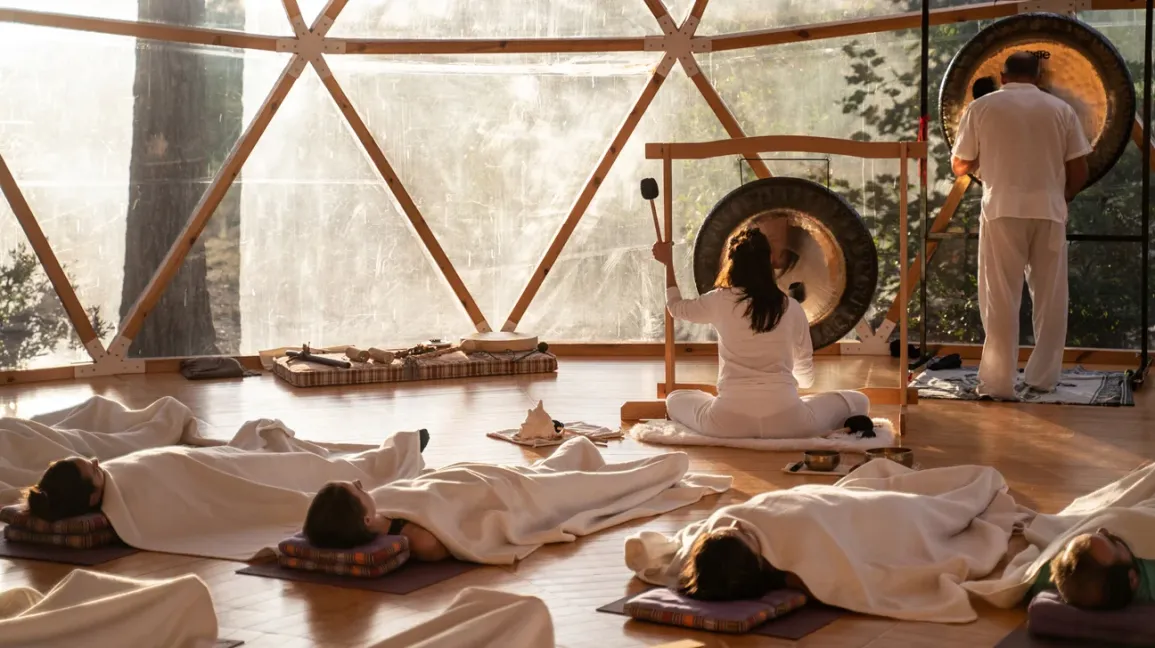
22 Jun 2025 Himalayan Yoga Academy
Yoga practice is slowly becoming an integral part of an individual for better physical health and mental clarity. Practicing Yoga is a boon which helps an individual to calm their mind, body, and soul. Yoga serves as a peaceful escape from their hectic schedule, bringing relaxation. Yoga is powerful on its own, but when combined with sound healing, it intensifies its benefits, promoting deep relaxation and inner balance. This blog will show you how to combine Yoga and Sound Healing for Deep Relaxation.
What is Sound healing?
Sound healing is an ancient therapeutic practice that uses sound frequencies to cure physical, emotional, or energetic imbalances. The vibrations from various instruments such as gongs, singing bowls, tuning forks, and drums are used for sound healing. The main purpose of sound healing is to restore balance within the body and mind.
Also Read: Understanding Sound Healing and Sound Baths
Why Combine Yoga and Sound Healing?
Yoga prepares the body and mind to be more approachable. Sound healing complements this by deepening relaxation, slowing brain waves, and enhancing the meditative state. Together, they:
- Reduce stress and anxiety
- Balance energy and chakras
- Improve sleep and emotional well-being
- Enhance mindfulness and spiritual connection

How to Combine Yoga and Sound Healing for Deep Relaxation?
A. Start with Gentle Movement or Restorative Yoga
Choose a slow-paced style like Yin Yoga, Restorative Yoga, and Hatha Yoga as these styles help calm the nervous system and prepare you to receive sound vibrations more fully.
Yin Yoga: long-held poses target connective tissues.
Restorative Yoga: uses props to fully support the body.
Hatha Yoga: slow movements with breath awareness.
Quick Tip: Dim the lights, light a candle, and create a cozy, quiet space.
B. Incorporate Sound Throughout the Practice
You can add sound in various ways:
Live Instruments: Use singing bowls, chimes, or gongs during long holds or savasana.
Background Soundtracks: Play recorded sound baths or binaural beats during the session.
Vocal Toning/Chanting: Begin or end with “Om” or mantra chanting to activate throat chakra and vibration in the body.
Quick Tip: Place singing bowls near the body or on the mat for deeper resonance.
C. Synchronize Sound with Breath and Movement
During the yoga flow, you can:
Use soft chimes to signal transitions.
Match breathing exercises (pranayama) with tonal background sounds.
Use hand-held instruments (like rain sticks or ocean drums) during breath work or meditative stillness.
Also Try: Alternate nostril breathing (Nadi Shodhana) followed by tuning fork tones to clear energy channels.
D. End with a Sound Bath in Savasana
This is the most powerful way to combine both practices:
Lie in Savasana (Corpse Pose) fully supported with blankets and cushions.
Use crystal bowls, gongs, or voice to create layered sound.
Let participants fully surrender into the vibrations for 10–20 minutes.
Note: Sound during savasana can induce theta brain waves, leading to deep healing and vivid inner awareness.

Benefits of Combining Yoga and Sound Healing
1. Deeper Relaxation
Sound slows down the mind, helping you enter a meditative state faster than yoga alone.
2. Heightened Body Awareness
Vibrations help you feel more connected to your body and breath, supporting mindful movement.
3. Energetic Balance
Different sounds resonate with different chakras, helping to clear blockages and enhance energetic flow.
4. Stress Reduction and Emotional Release
Both practices activate the parasympathetic nervous system, lowering cortisol and releasing held emotions.
5. Enhanced Spiritual Connection
Together, they open space for introspection, intuition, and inner peace.
Precautions and Considerations
Sound Sensitivity: People with anxiety or PTSD may feel overstimulated by certain instruments. Always start gently and check in.
Environment Matters: Choose a quiet, acoustically soft room to avoid harsh echoes.
Go Slow: Deep healing can bring up emotions. Practice integration after your sessions with journaling, grounding, or nature walks.
Conclusion
Combining yoga and sound healing is a deep therapeutic practice that offers deep relaxation through the power of vibration. The unison of body and sound allows an individual to connect with themselves and get to know them more deeply. So are you ready to experience it? Get ready, bring a yoga mat, a bowl (or a playlist), and surrender yourself to a quiet environment.
